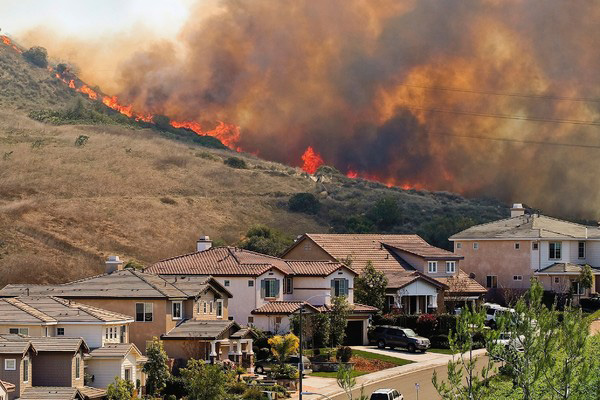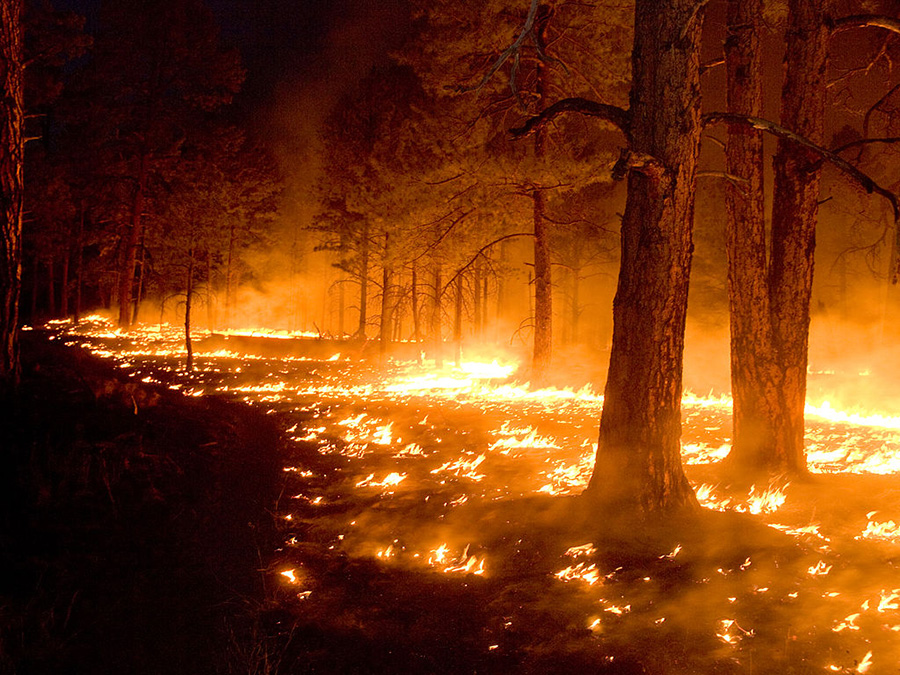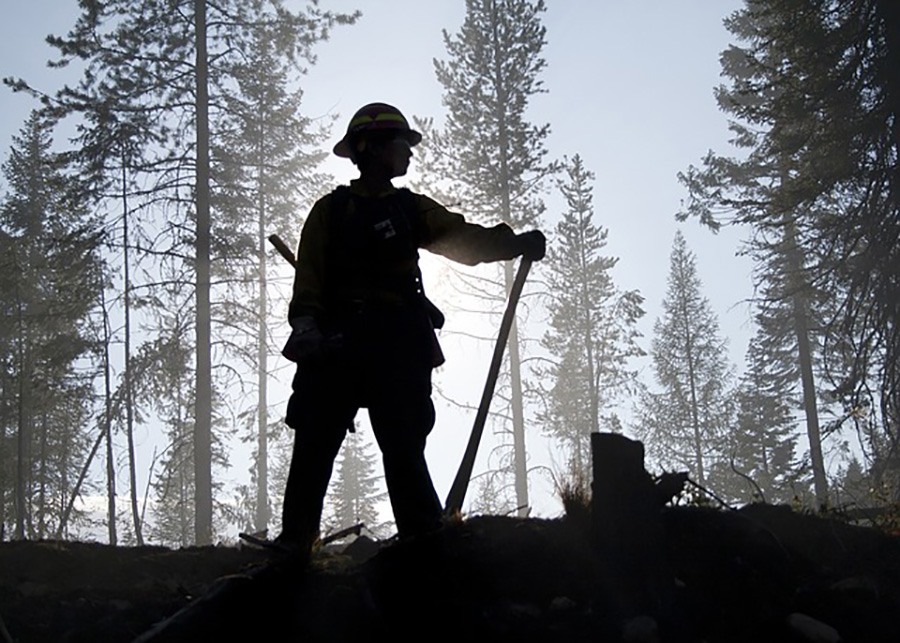Wildfires are one of the most common natural disasters in the United States. On average, there are more than 100,000 wildfires that burn 4 to 5 million acres across the country each year. Ninety percent of these fires are caused by humans with the most fire-prone regions being in the north-western states, like California, Washington, and Idaho. Fire is a strong force in nature and can be difficult to contain due to weather conditions like wind and drought. Fire can spread very quickly and can become out of control in the blink of an eye. However, there are a few precautions you can take to protect your home and your family.
-
- Create a Defensible Space
 A defensible space is the area between your house and the surrounding wildlands where you have modified the vegetation. In other words, it is the space in your yard where you have landscaped by either adding flower beds, lawns, and rocks that may include different types of plants than those found in the wild around your home. When creating a defensible space, you need to consider the vegetation surrounding your home, as well as the slope of your lot. If you have vegetation that tends to dry out in the summer, or if your lot is sloped, a larger defensible space is required because fire can more easily travel with those factors. A perimeter of 150 feet is recommended. If the lot is flat or vegetation is more lush, a defensible space of 30 feet is recommended.
A defensible space is the area between your house and the surrounding wildlands where you have modified the vegetation. In other words, it is the space in your yard where you have landscaped by either adding flower beds, lawns, and rocks that may include different types of plants than those found in the wild around your home. When creating a defensible space, you need to consider the vegetation surrounding your home, as well as the slope of your lot. If you have vegetation that tends to dry out in the summer, or if your lot is sloped, a larger defensible space is required because fire can more easily travel with those factors. A perimeter of 150 feet is recommended. If the lot is flat or vegetation is more lush, a defensible space of 30 feet is recommended.
- Break up Plant Layers
Separate layers of trees, shrubs, and flowers with non flammable materials like rocks and mulches that help retain the moisture of the soil. This prevents fires from easily jumping from plant to plant and getting closer to your home. It is also helpful to have structures like patios, pathways, sidewalks, and driveways or fences and walls of brick and stone that help to slow down the spread of fire.
- Eliminate Ladder Fuels
Remove plants that allow fire climb up from the ground onto taller plants like trees. Because of their taller height, trees make it easier for fire to make an adjacent jump onto your home. Reducing ladder fuels can help prevent this from happening.  Risk of ladder fuels can be reduced by creating a vertical separation between lower growing fuel and taller vegetation. A minimum of 3 feet is recommended. This can be done by cutting off lower tree branches, reducing the height of shrubs, or removing plants and shrubs around the base of trees altogether.
Risk of ladder fuels can be reduced by creating a vertical separation between lower growing fuel and taller vegetation. A minimum of 3 feet is recommended. This can be done by cutting off lower tree branches, reducing the height of shrubs, or removing plants and shrubs around the base of trees altogether.
- Maintain Your Yard
This suggestion is fairly straightforward. Keep your yard lean, clean, and green by keeping the area free of debris. Eliminate the accumulation of dead vegetation like pine needles and leaves that would fuel a wildfire. You should also keep your plants alive and healthy by watering them frequently throughout the fire season so they do not become easy fuel for a fire. Keeping your yard moist and green can help reduce the spread of a fire.
- Take Care of Large Debris
Similar to the previous suggestion, larger fuel sources like fallen or dead trees should be cleaned up from your yard. If there is a dead tree in or around your yard, cut it down and remove it from your yard. If a tree has fallen in your yard, it can be cut up and removed. You can also use a wood chipper for larger debris to make cleanup easier.
- Check Your Roof
Again, this precaution relates to eliminating debris that could be used as fuel for a fire. Make sure that your roof does not have debris build up in the gutters or along roof lines. You should also remove tree branches that hang over the roof or grow under the eaves. This is especially important if the branches actually touch the roof or grow within 15 feet of the chimney.  These items are easily combustible and could be a danger to your home. Roofs should be checked often, at least twice a year, for these conditions and should be taken care of immediately if they exist. You can also make your roof more fire-resistant by using fireproof or fire resistant shingles.
These items are easily combustible and could be a danger to your home. Roofs should be checked often, at least twice a year, for these conditions and should be taken care of immediately if they exist. You can also make your roof more fire-resistant by using fireproof or fire resistant shingles.
- Home Construction
If you are building a new home, consider where you are building in order to reduce fire danger. Avoid building on ridge tops and down in canyons. These areas tend to be windier and spread fire more quickly. You can also use fire resistant materials to build your home. If your home is not new, you can still add fire resistant material to give added protection to your home. You can enclose the underside of balconies, decks, and eaves with fireproof material. You can also consider installing a sprinkler system both on the inside and outside of your home. This can help prevent a house fire from causing a wildfire, especially if you are away.
If your community has a limited water supply, it is a good idea to have your own personal water storage. This could be a large, above ground water tank or even a swimming pool. Firefighters can use this water supply to fight a fire around your home. Make sure to clearly mark these water supplies so they can easily be located.
- Fireproof Signs and Access
Access to your property is important for both emergency vehicles to get to your home, as well as for you to evacuate, especially if your home is not visible from the main road. Visibility may be reduced from smoke and ash in the incident of a wildfire and it will be important to have a clearly marked address from the outside road, as well as a distinct route that is wide enough to accommodate firetrucks. It may also be a good idea to have an alternate route of access to your home if the main access is dangerous. 
- Emergency Planning
The best preparation for any disaster is to plan for it in advance. In case of a fire, make sure your family has a designated safe area where you can all meet if you are separated during the fire. Along with a safe meeting spot, you should also plan and discuss an evacuation route, how to secure your residence, what to pack if there is an evacuation,etc. Wildfire endanger thousands of homeowners every year and cause thousands of evacuations. However, by maintaining the vegetation around your house and taking other precautionary measures, you can be as ready as possible for a fire in your area.















